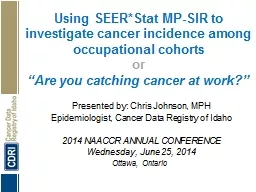

or Are you catching cancer at work Presented by Chris Johnson MPH Epidemiologist Cancer Data Registry of Idaho 2014 NAACCR ANNUAL CONFERENCE Wednesday June 25 2014 Ottawa Ontario ID: 913368
Download Presentation The PPT/PDF document "Using SEER*Stat MP-SIR to investigate ca..." is the property of its rightful owner. Permission is granted to download and print the materials on this web site for personal, non-commercial use only, and to display it on your personal computer provided you do not modify the materials and that you retain all copyright notices contained in the materials. By downloading content from our website, you accept the terms of this agreement.
Slide1
Using SEER*Stat MP-SIR to investigate cancer incidence among occupational cohortsor“Are you catching cancer at work?”
Presented by: Chris Johnson, MPH
Epidemiologist, Cancer Data Registry of Idaho
2014 NAACCR ANNUAL
CONFERENCE
Wednesday, June 25, 2014
Ottawa, Ontario
Slide2Many Thanks ToSteve Scoppa Senior Systems AnalystInformation Management Services Inc.
Angela Mariotto
Chief, Data Modeling BranchNational Cancer InstituteThe Centers for Disease Control and Prevention is acknowledged for support of CDRI under cooperative agreement U58DP003882. The findings and conclusions in this presentation are those of the authors and do not necessarily represent the official position of the Centers for Disease Control and Prevention or the National Cancer Institute.
2
Slide33
Slide44What is a disease cluster?A disease cluster is the occurrence of more than the expected number of people diagnosed with a certain disease within a specific group, a geographic area or a period of time.
Slide55Cancer Cluster Investigation ThemesOccupational and medical clusters have aided our understanding of cancer etiology.Studies of geographic clusters rarely identify environmental risk factors. Science can be overtaken by public concern.
Geography might be symptom rather than cause.
Slide66CDRI has a protocol for investigating non-infectious disease clusters
Slide77CDRI is developing a protocol for investigating worksite/occupational cancer clusters
CDRI Protocol
Worksite Cancer
Clusters??? 2014
Slide8Two Recent Worksite/Occupational Cancer Cluster InvestigationsStudy #1 - WorksiteStudy #2 – Occupational group (licensed)
8
Slide9Study #2 – BackgroundAn oncologist noticed what she believed to be an unusually large number of cases in a particular occupational group (licensed professional) among her patients.October 2013: this concern was brought to the state of Idaho Board that governs this group.January 2014: the Board voted to share data with CDRI to investigate the concern.
9
Slide10Study #2 – BackgroundFebruary 2014: CDRI received dataset on the current and historical licensed professionalsNo SSNMonth and year of birth, not day February-March 2014: deduplication, linkages, Accurint & SSDI lookups April 2014: statistical analysisMay 2014: report writing
??? 2014: meet with Board to share results
At least 8 months…
10
Slide11Mock-up of Case and Person-time Contributions by Licensed Professional11
Slide1212
Slide13Study #2 – Statistical MethodsWe compared the observed numbers of cancer cases among occupational cohort to expected numbers based on referent rates from Idaho and the US.Standardized incidence
ratio
(SIR
) = obs/expReferent rates:National Cancer Institute’s Surveillance, Epidemiology, and End Results Program (SEER ) for whitesIdaho overallResults were tabulated using CDRI annual report primary site categories, which include malignant cases and benign brain and other nervous system cases.
13
Slide14SEER*Stat MP-SIR SessionMP-SIR (Multiple Primary -- Standardized Incidence Ratios) sessions can be used to compare incidence of cancer in a defined cohort of persons previously diagnosed with cancer to the incidence of cancer in the general population.Can also be used to compare incidence of cancer in other cohorts to the incidence of cancer in the general population
.
14
Slide1515
Slide1616
Slide1717
Slide18Study #2 – ResultsAnalytic datasets contained 881 records. If a person in the occupational cohort did not link to CDRI, they have 1 record for person-time calculations. For persons who did link to CDRI, they have one record for every primary cancer case.86 cancer cases among cohort, spanning 1971-2013.
59
deceased persons in cohort.
As with Study #1, some cancer cases occurred before the person joined the occupational cohort. 18
Slide19Study #2 – Results – Table 119
Slide20Study #2 – Results – Table 220
Slide21Study #2 – Results – Table 321
Slide22Lessons Learned from the 2 StudiesCDRI not in control of employer/licensure dataAvailabilityContentCompletenessTimeliness
May take a long time from initial request to final report
What you have to do in terms of data cleanup, extra linkages, depends on employer dataDifficulty of linkages with cancer registry depends on fields available from employer data and data quality22
Slide23Lessons Learned from the 2 StudiesInterpretability of results may be contingent on structure of human resources databaseCompared to geographic cancer clusters, seemingly more buy-in from concerned persons if negative resultsSEER*Stat provides a user-friendly interface and consistent approach to conducting worksite/occupational cancer cluster investigations
23
Slide24SEER*Stat MP-SIRIt is hoped that this approach to the analysis of cancer incidence among occupational cohorts could be easily adopted by other central cancer registries and will be a useful model for addressing worksite cancer cluster concerns.“SEER*Stat does that!”
24
Slide2525Thank YouChris Johnson, CDRI Epidemiologist208-489-1380
cjohnson@teamiha.org
www.idcancer.org